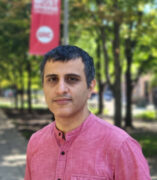
Kaveh Rafie
Resident Graduate Scholar
Department of Philosophy
About
Pleated Modernity: Modern Art in Iran, 1941 – 1979
As Iranian artists became disillusioned with internationalism and frustrated with attempts to create a democratic Iran in the 1950s, they began exploring local cultural traditions as the basis for a new culture. They gradually sought refuge in a communal identity, or “return to the fold,” so to speak. I claim that the infatuation of many of these artists with fabric should not be solely associated with a propensity for indigeneity of design concepts—which was in part true—but also with a desire for a certain way of worldmaking embodied by the fold. My study examines the ways in which the state, cultural operatives, and artists contested the meaning of Iranian modern art to promulgate a sense of national identity between 1941 and 1979. Furthermore, it proposes a framework for navigating between national and transnational art historical approaches, which often err on the side of isolating localism or blandly general globalism. Because modern art in the late Pahlavi period consistently holds the opposing forces of centripetal nativism and centrifugal cosmopolitanism on the same plane, it is best understood to engage in a folding operation that brings a traditional, even “primitive” past into jarring juxtaposition with the aesthetic languages of a global capitalist marketplace in which “nations” compete for economic sovereignty.